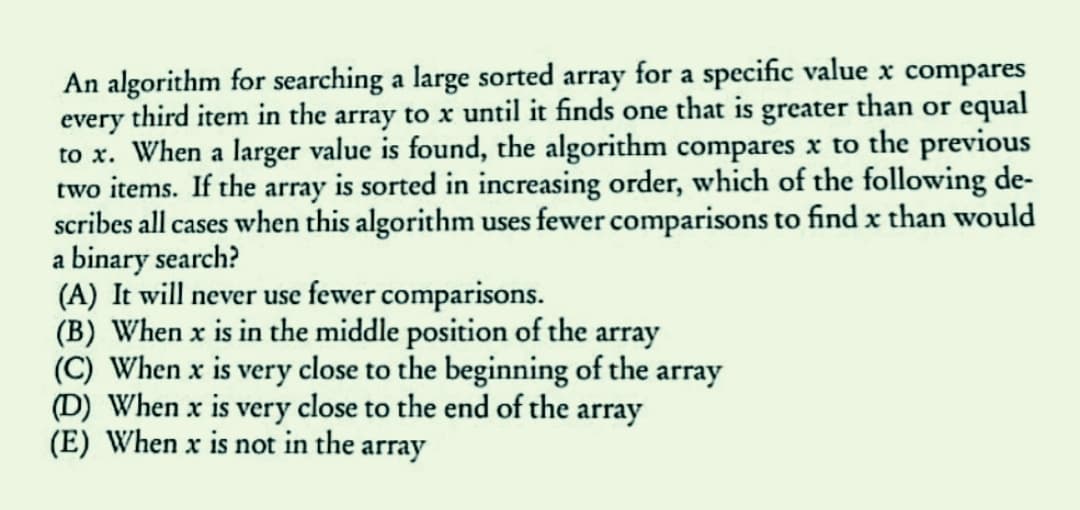An algorithm for searching a large sorted array for a specific value x compares every third item in the array to x until it finds one that is greater than or equal to x. When a larger value is found, the algorithm compares x to the previous two items. If the array is sorted in increasing order, which of the following de- scribes all cases when this algorithm uses fewer comparisons to find x than would a binary search? (A) It will never use fewer comparisons. (B) When x is in the middle position of the array (C) When x is very close to the beginning of the array (D) When x is very close to the end of the array (E) When x is not in the array
An algorithm for searching a large sorted array for a specific value x compares every third item in the array to x until it finds one that is greater than or equal to x. When a larger value is found, the algorithm compares x to the previous two items. If the array is sorted in increasing order, which of the following de- scribes all cases when this algorithm uses fewer comparisons to find x than would a binary search? (A) It will never use fewer comparisons. (B) When x is in the middle position of the array (C) When x is very close to the beginning of the array (D) When x is very close to the end of the array (E) When x is not in the array
Database System Concepts
7th Edition
ISBN:9780078022159
Author:Abraham Silberschatz Professor, Henry F. Korth, S. Sudarshan
Publisher:Abraham Silberschatz Professor, Henry F. Korth, S. Sudarshan
Chapter1: Introduction
Section: Chapter Questions
Problem 1PE
Related questions
Question

Transcribed Image Text:An algorithm for searching a large sorted array for a specific value x compares
every third item in the array to x until it finds one that is greater than or equal
to x. When a larger value is found, the algorithm compares x to the previous
two items. If the array is sorted in increasing order, which of the following de-
scribes all cases when this algorithm uses fewer comparisons to find x than would
a binary search?
(A) It will never use fewer comparisons.
(B) When x is in the middle position of the array
(C) When x is very close to the beginning of the array
(D) When x is very close to the end of the array
(E) When x is not in the array
Expert Solution
This question has been solved!
Explore an expertly crafted, step-by-step solution for a thorough understanding of key concepts.
Step by step
Solved in 2 steps with 2 images

Knowledge Booster
Learn more about
Need a deep-dive on the concept behind this application? Look no further. Learn more about this topic, computer-science and related others by exploring similar questions and additional content below.Recommended textbooks for you

Database System Concepts
Computer Science
ISBN:
9780078022159
Author:
Abraham Silberschatz Professor, Henry F. Korth, S. Sudarshan
Publisher:
McGraw-Hill Education

Starting Out with Python (4th Edition)
Computer Science
ISBN:
9780134444321
Author:
Tony Gaddis
Publisher:
PEARSON

Digital Fundamentals (11th Edition)
Computer Science
ISBN:
9780132737968
Author:
Thomas L. Floyd
Publisher:
PEARSON

Database System Concepts
Computer Science
ISBN:
9780078022159
Author:
Abraham Silberschatz Professor, Henry F. Korth, S. Sudarshan
Publisher:
McGraw-Hill Education

Starting Out with Python (4th Edition)
Computer Science
ISBN:
9780134444321
Author:
Tony Gaddis
Publisher:
PEARSON

Digital Fundamentals (11th Edition)
Computer Science
ISBN:
9780132737968
Author:
Thomas L. Floyd
Publisher:
PEARSON

C How to Program (8th Edition)
Computer Science
ISBN:
9780133976892
Author:
Paul J. Deitel, Harvey Deitel
Publisher:
PEARSON

Database Systems: Design, Implementation, & Manag…
Computer Science
ISBN:
9781337627900
Author:
Carlos Coronel, Steven Morris
Publisher:
Cengage Learning

Programmable Logic Controllers
Computer Science
ISBN:
9780073373843
Author:
Frank D. Petruzella
Publisher:
McGraw-Hill Education